Abstract
We have endeavoured to find immunological indications of chronic virus infection in patients with chronic fatigue syndrome (myalgic encephalomyelitis) and to investigate immune responsiveness to viruses in such patients in comparison with normal subjects and patients with muscular dystrophy. Levels of circulating IgM immune complexes were elevated (above the 95% normal control range) in 10 (17%) of 58 patients with chronic fatigue syndrome, which was not significantly different from the normal controls or from dystrophy controls (by Mann Whitney U test). Levels of IgG complexes were only increased in 10% of patients. Lymphocyte proliferation in response to concanavalin A (Con A), assessed by increase in 3H-thymidine incorporation, did not differ between 14 patients and 18 normal subjects. The proliferative response to Coxsackie B virus antigen did not differ between chronic fatigue patients and normal subjects when expressed either as an increase in counts or as a stimulation index. Adjustment of the counts in relation to the proliferation response to Con A, as an indication of the overall proliferative response of the cell preparation, did not reveal any hidden difference. IgM antibodies to Coxsackie B viruses were not found in any of 20 patients and in 1 of 20 dystrophy controls. Significant levels of neutralizing antibodies to Coxsackie B viruses 1-5 were found in 6 out of 19 (32%) patients compared with 4 out of 17 (24%) dystrophy controls, which does not differ from currently expected normal incidence. Antibody titres to other respiratory viruses were also not notably different between the patient and control groups. In conclusion we can find no evidence for a definable viral aetiology for the chronic fatigue syndrome, neither in terms of a persistent infection nor an altered ability to respond to virus.
Full text
PDF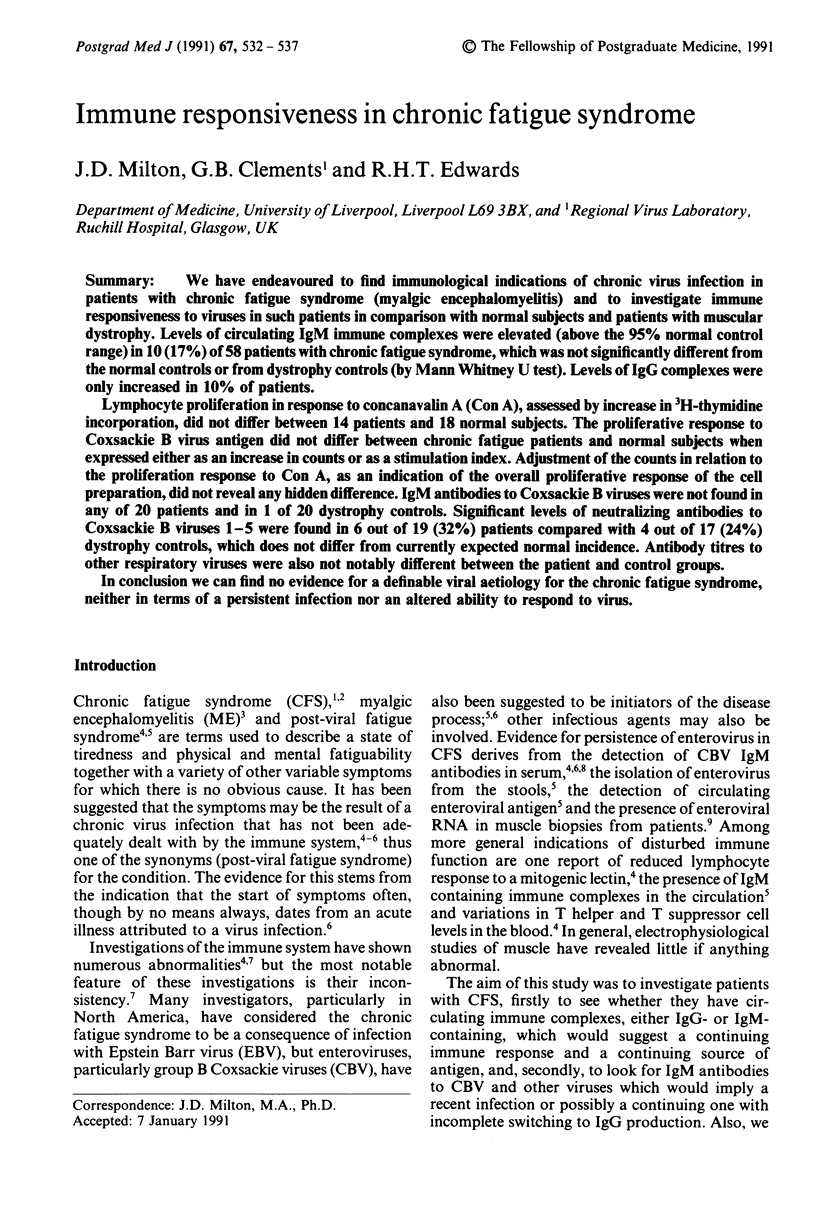
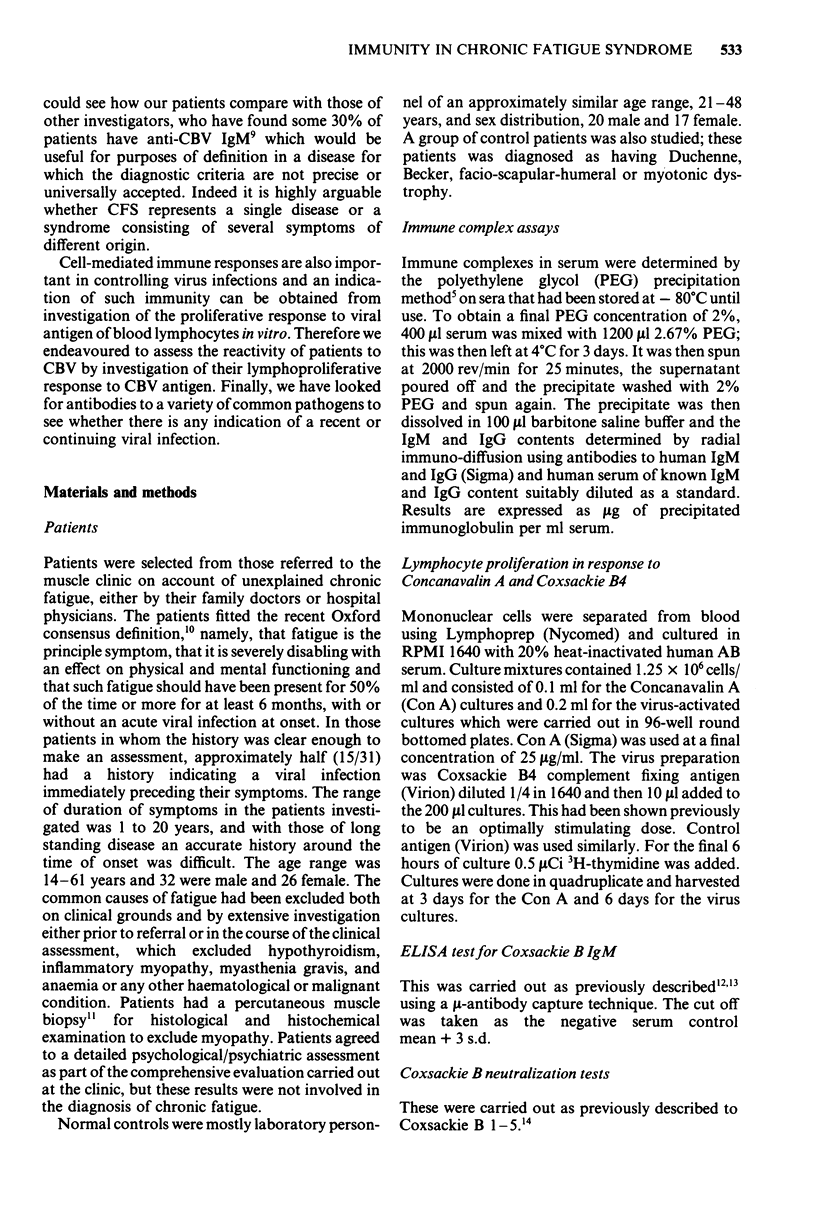
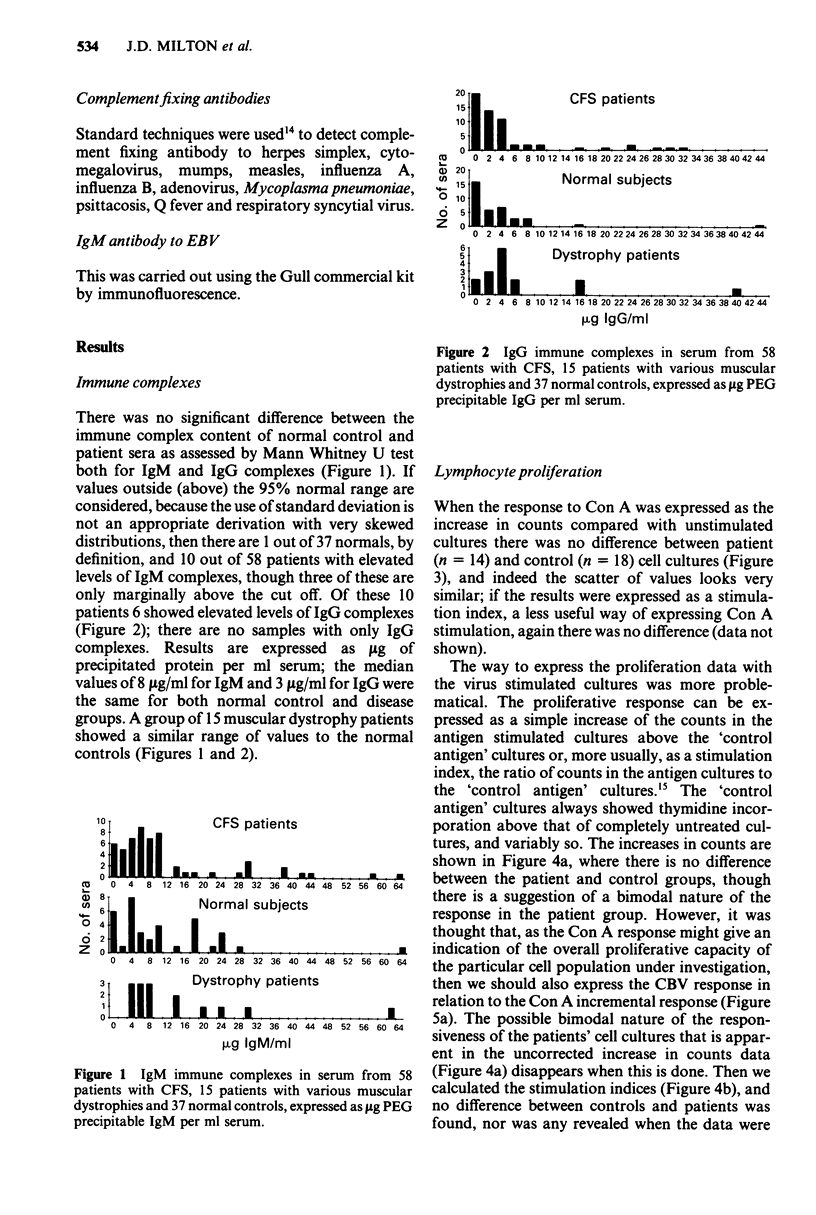
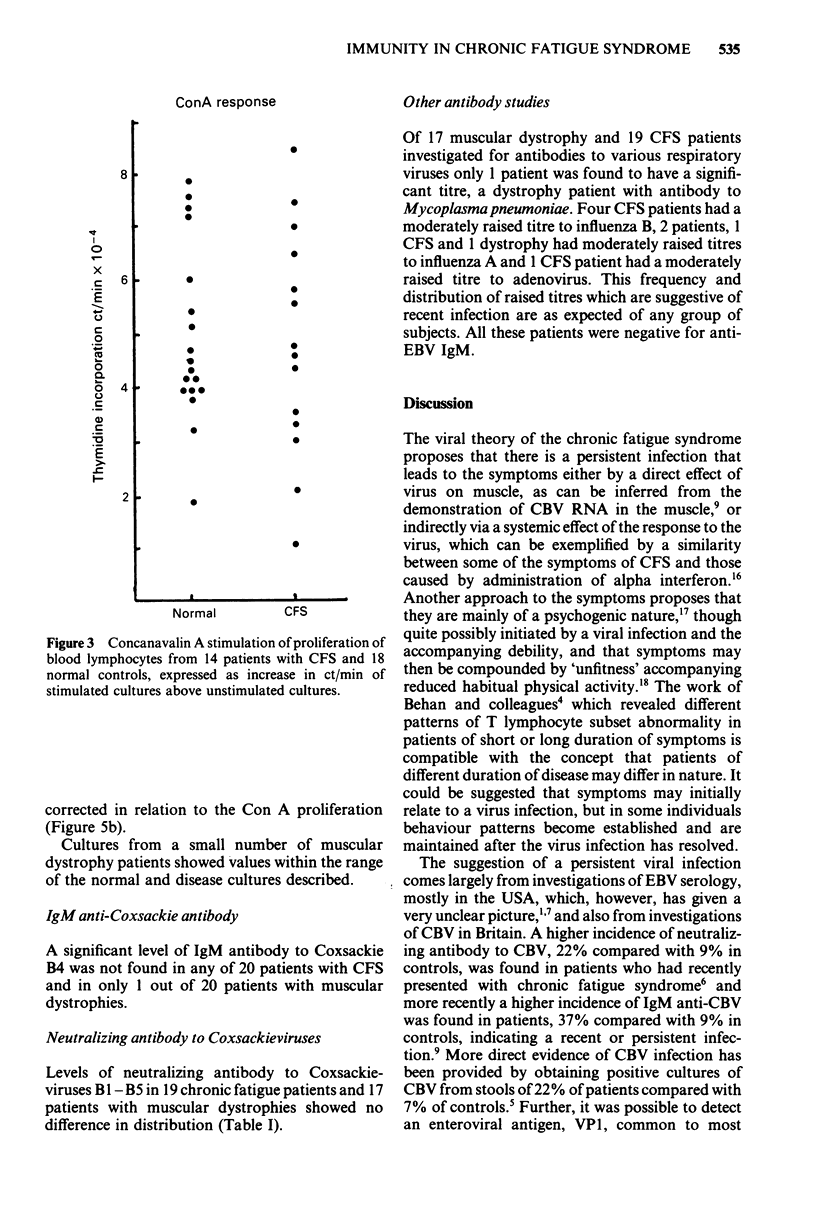

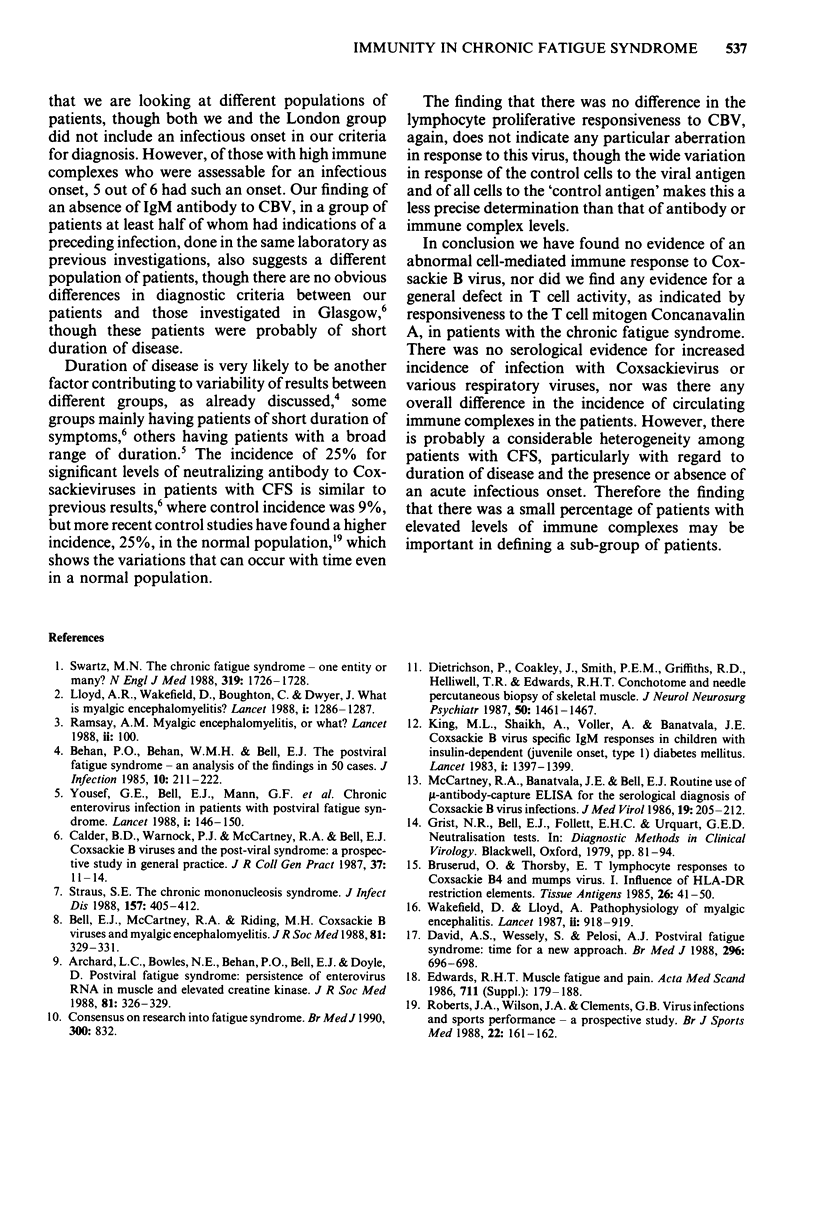
Selected References
These references are in PubMed. This may not be the complete list of references from this article.
- Archard L. C., Bowles N. E., Behan P. O., Bell E. J., Doyle D. Postviral fatigue syndrome: persistence of enterovirus RNA in muscle and elevated creatine kinase. J R Soc Med. 1988 Jun;81(6):326–329. doi: 10.1177/014107688808100608. [DOI] [PMC free article] [PubMed] [Google Scholar]
- Behan P. O., Behan W. M., Bell E. J. The postviral fatigue syndrome--an analysis of the findings in 50 cases. J Infect. 1985 May;10(3):211–222. doi: 10.1016/s0163-4453(85)92488-0. [DOI] [PubMed] [Google Scholar]
- Bell E. J., McCartney R. A., Riding M. H. Coxsackie B viruses and myalgic encephalomyelitis. J R Soc Med. 1988 Jun;81(6):329–331. doi: 10.1177/014107688808100609. [DOI] [PMC free article] [PubMed] [Google Scholar]
- Bruserud O., Thorsby E. T lymphocyte responses to Coxsackie B4 and mumps virus. I. Influence of HLA-DR restriction elements. Tissue Antigens. 1985 Jul;26(1):41–50. doi: 10.1111/j.1399-0039.1985.tb00933.x. [DOI] [PubMed] [Google Scholar]
- Calder B. D., Warnock P. J., McCartney R. A., Bell E. J. Coxsackie B viruses and the post-viral syndrome: a prospective study in general practice. J R Coll Gen Pract. 1987 Jan;37(294):11–14. [PMC free article] [PubMed] [Google Scholar]
- David A. S., Wessely S., Pelosi A. J. Postviral fatigue syndrome: time for a new approach. Br Med J (Clin Res Ed) 1988 Mar 5;296(6623):696–699. doi: 10.1136/bmj.296.6623.696. [DOI] [PMC free article] [PubMed] [Google Scholar]
- Dietrichson P., Coakley J., Smith P. E., Griffiths R. D., Helliwell T. R., Edwards R. H. Conchotome and needle percutaneous biopsy of skeletal muscle. J Neurol Neurosurg Psychiatry. 1987 Nov;50(11):1461–1467. doi: 10.1136/jnnp.50.11.1461. [DOI] [PMC free article] [PubMed] [Google Scholar]
- Edwards R. H. Muscle fatigue and pain. Acta Med Scand Suppl. 1986;711:179–188. doi: 10.1111/j.0954-6820.1986.tb08948.x. [DOI] [PubMed] [Google Scholar]
- King M. L., Shaikh A., Bidwell D., Voller A., Banatvala J. E. Coxsackie-B-virus-specific IgM responses in children with insulin-dependent (juvenile-onset; type I) diabetes mellitus. Lancet. 1983 Jun 25;1(8339):1397–1399. doi: 10.1016/s0140-6736(83)92353-x. [DOI] [PubMed] [Google Scholar]
- Lloyd A. R., Wakefield D., Boughton C., Dwyer J. What is myalgic encephalomyelitis? Lancet. 1988 Jun 4;1(8597):1286–1287. doi: 10.1016/s0140-6736(88)92107-1. [DOI] [PubMed] [Google Scholar]
- McCartney R. A., Banatvala J. E., Bell E. J. Routine use of mu-antibody-capture ELISA for the serological diagnosis of Coxsackie B virus infections. J Med Virol. 1986 Jul;19(3):205–212. doi: 10.1002/jmv.1890190302. [DOI] [PubMed] [Google Scholar]
- Roberts J. A., Wilson J. A., Clements G. B. Virus infections and sports performance--a prospective study. Br J Sports Med. 1988 Dec;22(4):161–162. doi: 10.1136/bjsm.22.4.161. [DOI] [PMC free article] [PubMed] [Google Scholar]
- Straus S. E. The chronic mononucleosis syndrome. J Infect Dis. 1988 Mar;157(3):405–412. doi: 10.1093/infdis/157.3.405. [DOI] [PubMed] [Google Scholar]
- Swartz M. N. The chronic fatigue syndrome--one entity or many? N Engl J Med. 1988 Dec 29;319(26):1726–1728. doi: 10.1056/NEJM198812293192608. [DOI] [PubMed] [Google Scholar]
- Wakefield D., Lloyd A. Pathophysiology of myalgic encephalitis. Lancet. 1987 Oct 17;2(8564):918–919. doi: 10.1016/s0140-6736(87)91408-5. [DOI] [PubMed] [Google Scholar]
- Yousef G. E., Bell E. J., Mann G. F., Murugesan V., Smith D. G., McCartney R. A., Mowbray J. F. Chronic enterovirus infection in patients with postviral fatigue syndrome. Lancet. 1988 Jan 23;1(8578):146–150. doi: 10.1016/s0140-6736(88)92722-5. [DOI] [PubMed] [Google Scholar]


